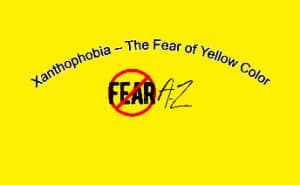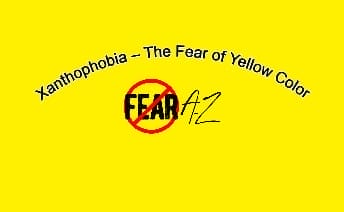Share This Article
The Fear of Yellow? Yellow Is a Dominant Color that Scares Some People
Yellow is easy to spot even from a distance. That’s why school buses, stoplights, and signs make use of this eye-catching color.
Surprisingly, some people are scared of this cheerful hue. Are you one of them? If you not only dread the yellow color but also experience unimaginable anxiety when you see it, you may have xanthophobia.
As strange as it may seem, the fear of yellow is real. It may be hard trying to explain to someone why you hate yellow. What can you do about recovery? Let’s explore the causes and possible treatments for the fear of yellow.
Quick Fact: Did you know yellow is the most visible color in the daytime?

What Is Xanthophobia or the Fear of Yellow?
What is the fear of yellow called? Xanthophobia is a specific color phobia. It is derived from two words: the Greek word xantho, meaning yellow, and phobos, meaning fear. Xanthophobia should not be confused with chromophobia (also spelled as or chromatophobia or chrematophobia), which is the irrational fear of colors. A person with the phobia of the yellow color is better known as a xanthophobe. They have an extreme fear of yellow, which goes beyond minor discomfort or disgust.
The fear of the color yellow can be frustrating. While other phobias, like animal phobias, are well understood, xanthophobia has not been given much attention in the medical field. Xanthophobes thus suffer in silence from one of the least talked about phobias.
Xanthophobes will take pains to stay away from anything yellow. Some balk at riding a yellow school bus or taxi. They may be terrified of a certain Beatles album that features a yellow submarine. Others avoid food like cheese, mustard, bananas, or lemons for the same reason.
When a xanthophobe encounters anything yellow-tinted, they might close their eyes in panic. Some of them may start to hyperventilate at merely reading the word “yellow” or hearing someone mention this innocent-looking shade. What percentage of people have Xanthophobia? There’s no conclusive information on the number of people who have this rare phobia. One source claims that about 5 to 10 percent of people have chromatophobia (general fear of colors).
Xanthophobia Causes
Researchers have not yet identified one particular cause for phobia. Instead, a combination of factors could lead to dreading the color yellow. Medical professionals accept that phobias are caused by both internal predispositions like genetics or external events like trauma. Let’s look at these in detail.
Traumatic Experiences
Do you have a painful or unpleasant memory that involved something yellow? For instance, you may have been stung by a yellow-bodied wasp. Perhaps you were abused or bullied by a person who always wore yellow. You could also have been hit by a yellow bus or truck. Or you may have experienced severe food poisoning after eating something yellow like curry or cheese. This unhappy experience is a significant contributor to phobia. Long after this incident, anything yellow may remind you of that moment.
Genetics
Ask your parents or grandparents if there is a history of phobias in your family. The tendency to get phobias can be passed down from one generation to the next. In addition, if there is a history of social anxiety disorders or mental illness in your family, you are at a higher risk of developing xanthophobia.
Media
Sometimes this fear is brought about by the popular media. You may have read a creepy book like The King in Yellow or watched a movie about a murderous clown wearing a yellow suit. These make-believe stories can give you a negative impression of this color.
Diseases
Yellow is associated with contagious diseases or serious illnesses. Patients are often described as having a sallow or sickly yellow complexion. This is especially true for people with hepatitis, a liver ailment that can be fatal if untreated. Parents get alarmed when their newborns get jaundice.
Social Conditioning
Colors are neutral, but we soon learn to associate particular shades with specific meanings. In some cultures, yellow is associated with cowardice, jealousy, or deception. Since it’s highly visible, yellow is used for crime scene tape or biohazard signs. Because of this, many associate yellow with danger and death. Do you remember any incident where the color yellow was not appreciated in your home? Children may also pick up from their families of origin that yellow is an undesirable color. No matter the cause, this phobia can have an impact on your life and health.
Xanthophobia Symptoms
Phobias have plenty of visible and hidden symptoms in common. The severity of these symptoms varies per individual. Also, a xanthophobe may not experience all of these signs.
Physical Symptoms
- Increased heart rate
- Sweating
- Hot flashes
- Nausea and vomiting
- Diarrhea
- Shaking and trembling
- Breathing difficulties
- Chest pains
- Numbness
Mental/Emotional Symptoms
- Obsession over anything yellow
- Expecting something terrible to happen when you encounter yellow
- Panic attacks
- Chronic anxiety
- Avoiding anything yellow
- Lack of concentration
Self-Help Tips for Xanthophobia
There’s no pill available yet for xanthophobia treatment. But don’t fret. There are plenty of techniques that will help manage these symptoms and contribute to your general well-being. Here are some strategies you can practice at home:
Unlearn Negative Ideas
You need to let go of any social conditioning or beliefs that consider yellow as bad or dangerous. Instead, replace them with the positive aspects of this shade. Some of the positive associations with yellow are happiness, energy, sunlight, and youth.
Apply Relaxation Techniques
Relaxation techniques include controlled breathing and meditation. Before leaving your home, breathe in and out as many times as necessary until you feel relaxed. Controlled breathing calms you down especially during panic attacks.
Talk with Someone
They say that a problem shared is half solved. Find someone who you can open up to about this phobia. It could be a close friend or a family member. Ask this person to listen to you and try to understand without judgement.
Professional Treatment for Xanthophobia
If DIY techniques aren’t effective, here are some methods you can explore with a licensed therapist.
Exposure Therapy
This is an effective intervention where you’re exposed to the thing you dread. Over time, you learn to manage symptoms in a controlled environment. Gradually, you’ll be asked to touch yellow, wear yellow, or eat yellow. A professional health expert will walk you through the journey.
Group Therapy
Instead of having one listener, you’ll share your phobia experiences in a group setting. Group members have the same problem as you do. Group recovery is beneficial. For starters, you’ll get tips that have worked for others which you can apply in your situation. You can learn a lot from those who have already made steps toward recovery. Also, there’s nothing like meeting those who can relate to having an overwhelming fear of the color yellow.
How to Cope Altogether
Unfortunately, less than half of phobia sufferers seek treatment for this condition. If you wish to overcome xanthophobia, you need to take action. Be prepared to try numerous treatment methods until you find the combination that will work for you. At the same time, the best thing you can offer yourself is kindness and patience. Phobia treatment is a long-term process. If you start to feel discouraged, remind yourself that you are in control of your life—not your phobia.
Conclusion
A phobia is as big as you make it. All fears are in the mind. If you can win the battle in your mind, then you have conquered everything that seeks to alter your normal functioning. While treatment may not always eliminate xanthophobia, it can help you cope and lead a more fulfilled life. Soon, you can eat that slice of lemon pie without fear of the color yellow.



